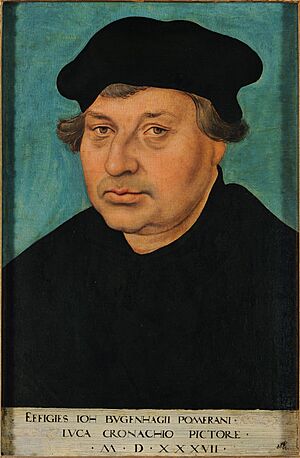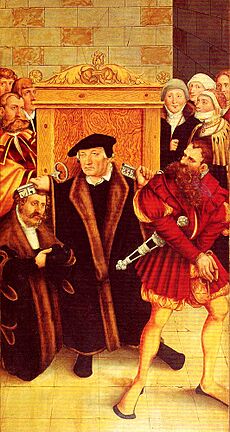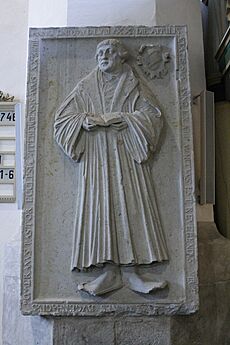Johannes Bugenhagen facts for kids
Quick facts for kids
Johannes Bugenhagen
|
|
|---|---|

Bugenhagen in 1537 by Lucas Cranach
|
|
| Born | 24 June 1485 |
| Died | 20 April 1558 (aged 72) |
| Occupation | Priest, Theologian |
| Spouse(s) | Walpurga Bugenhagen, maiden name unknown (13 October 1522) |
| Children | Johannes (the Younger, 1531/2–1592, professor for theology at the University of Wittenberg) Martha Sara |
| Theological work | |
| Era | Reformation |
| Tradition or movement | Lutheranism |
| Signature | |
Johannes Bugenhagen (born June 24, 1485 – died April 20, 1558) was an important German priest and theologian. His friend, Martin Luther, called him Doctor Pomeranus. Bugenhagen helped bring the Protestant Reformation to places like Pomerania and Denmark in the 1500s.
He was very good at organizing things. He helped set up Lutheran churches across Northern Germany and Scandinavia. Because of his big impact, some people called him the "Second Apostle of the North."
Johannes Bugenhagen was also the pastor for Martin Luther himself at St. Mary's church in Wittenberg. The Lutheran Church–Missouri Synod remembers him as a special pastor on April 20 each year.
Contents
His Life Story
Early Years and Education
Johannes Bugenhagen was born in a town called Wollin (now Wolin) in Pomerania. This was on June 24, 1485. He was one of three children.
From 1502 to 1504, he studied at the University of Greifswald. In 1504, he moved to Treptow an der Rega (now Trzebiatów). There, he became the head teacher, or rector, of the local school. Even though he hadn't studied theology, he became a priest in 1509. He then worked as a vicar at St. Mary's Church in Treptow.
In 1517, a leader named Johann Boldewan asked Bugenhagen to teach about the Bible. They worked together at Belbuck Abbey. They became the center of a group of scholars who loved learning, called Humanists. The Duke of Pomerania, Bogislav X, even asked Bugenhagen to write down the history of Pomerania in Latin.
Discovering Luther's Ideas
Bugenhagen first learned about Martin Luther's ideas in 1520. At first, he didn't like them at all. But after he studied Luther's writings more closely, Bugenhagen changed his mind. He became a strong supporter of the Reformation. In 1521, he moved to Wittenberg, where Luther lived.
Life in Wittenberg
In Wittenberg, Bugenhagen became the local church pastor on October 25, 1523. This meant he was Martin Luther's own pastor and someone Luther would talk to about his faith. Bugenhagen was also part of Luther's team that translated the Holy Bible into German. They translated it from the original Greek and Hebrew languages.
By 1523, Bugenhagen's lessons were very popular. He was asked to teach at the Leucorea, which was the university in Wittenberg. In 1524, his book "Interpretations of the Psalms" was printed. This book was very popular and had many editions. Bugenhagen became known as a very important teacher of the Bible during the Protestant Reformation. He helped train many Lutheran pastors at the university.
On March 17, 1533, Bugenhagen earned his doctor's degree in theology from the University of Wittenberg. He was one of the first three Protestant doctors of theology. This was a very important event for the new Protestant movement.
Important Reform Work
Bugenhagen became a key leader in the Protestant Reformation in Northern Germany and Scandinavia. He wrote new "church orders" for many cities and regions. These orders were like rulebooks for how the church should run. They covered religious services, schooling, and how the church should help with social issues.
He created these rules for places like Hamburg (1528/29), Lübeck (1530–1532), and Denmark-Norway (1537). In Denmark, he even crowned King Christian III. This is why he was called the "Second Apostle of the North." He didn't just write the rules; he also helped put them into practice.
In 1539, he became the superintendent of the Lutheran Church in Saxony. A superintendent is like a main leader or supervisor for the churches in a region. Also in 1539, Bugenhagen helped restart the University of Greifswald as a Protestant university. He based it on the university in Wittenberg.
Later Life
After Martin Luther died in 1546, Bugenhagen took care of Luther's wife and children. Johannes Bugenhagen died in Wittenberg in 1558. He was buried at St. Mary's Church in Wittenberg. This church also has a special painting that remembers Bugenhagen.
Besides his religious ideas, Bugenhagen was also known for his great organizing skills. He also helped translate Luther's Bible into a language called Middle Low German in 1534. This made the Bible easier for more people to read.
Johannes Bugenhagen always had the heart of a pastor. He loved music, and because of this, his family's symbol, or coat of arms, shows a harp.
Family
His daughter Sara (who died in 1563) married a man named Georg Cracow.
See also
- Pomerania during the Early Modern Age
- Reformation in Denmark-Norway and Holstein
- Epistle to the English





